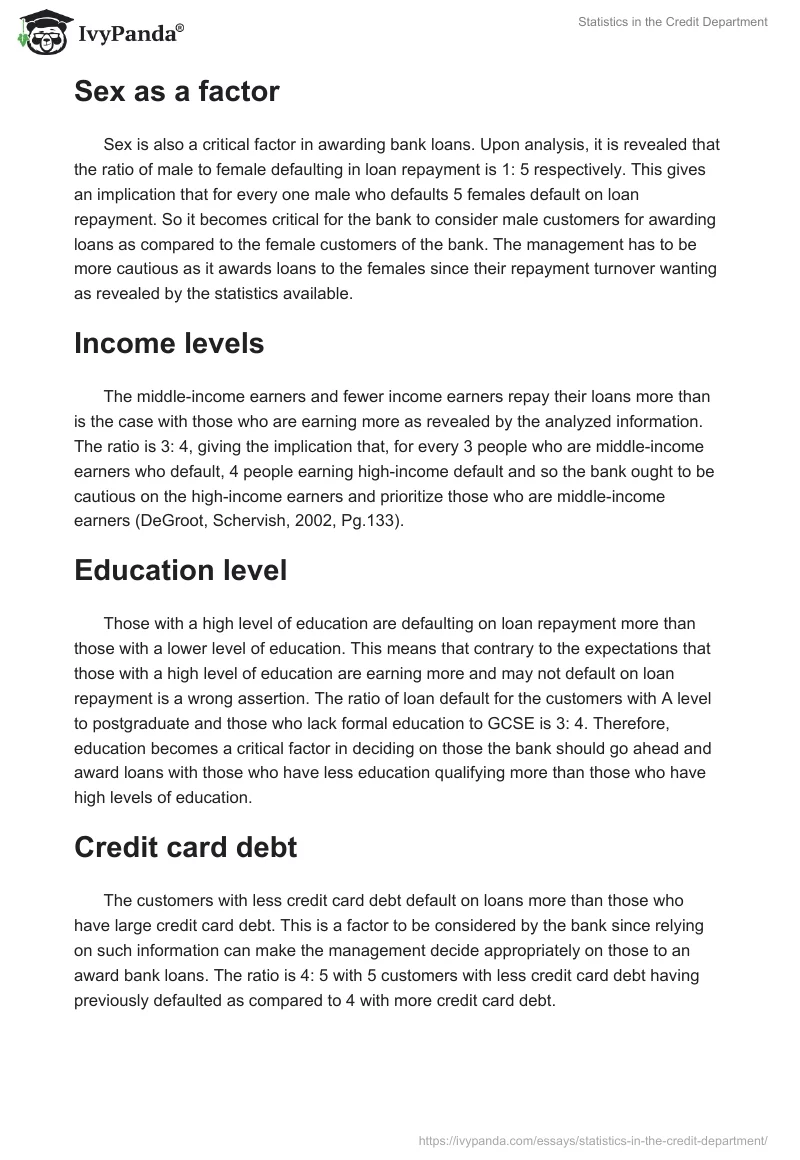Summary of data analyzed
In analyzing the excel data provided from the bank for customers who have previously been granted bank loans the following are the factors that should be considered when determining whether a prospective customer is suitable to be granted a loan. The data analyzed was for 100 customers who defaulted on their loan payment by missing one or more repayments and 100 customers who did not default on their loan by making every payment.
Years spent with the current employer
One of the factors that should be considered in awarding the bank customers loans is the years they have been with the current employer. The data shows that those who have been with their current employers for a few years have not defaulted on their loan repayments as compared to those who have been with their current employers for a long period. For example, those who have been with their employers for 19 years and above have not been repaying their loans with the statistics showing nearly 98% of them have defaulted (Spiegel, Schiller, Srinivasan, 2009, pp.1-20).
The age factor
Age should also be considered in awarding loans by the bank. It is very interesting to find many of those who have defaulted on their loan repayment are between the ages of 21-33 with those beyond that age doing well in their payment. Only 63 customers between the age of 21 and 33 have been repaying their loans as compared to 100 who are between the ages of 33 and 55. Therefore, it’s important to consider the age of the customers as the decision to award a bank loan is considered.
Sex as a factor
Sex is also a critical factor in awarding bank loans. Upon analysis, it is revealed that the ratio of male to female defaulting in loan repayment is 1: 5 respectively. This gives an implication that for every one male who defaults 5 females default on loan repayment. So it becomes critical for the bank to consider male customers for awarding loans as compared to the female customers of the bank. The management has to be more cautious as it awards loans to the females since their repayment turnover wanting as revealed by the statistics available.
Income levels
The middle-income earners and fewer income earners repay their loans more than is the case with those who are earning more as revealed by the analyzed information. The ratio is 3: 4, giving the implication that, for every 3 people who are middle-income earners who default, 4 people earning high-income default and so the bank ought to be cautious on the high-income earners and prioritize those who are middle-income earners (DeGroot, Schervish, 2002, Pg.133).
Education level
Those with a high level of education are defaulting on loan repayment more than those with a lower level of education. This means that contrary to the expectations that those with a high level of education are earning more and may not default on loan repayment is a wrong assertion. The ratio of loan default for the customers with A level to postgraduate and those who lack formal education to GCSE is 3: 4. Therefore, education becomes a critical factor in deciding on those the bank should go ahead and award loans with those who have less education qualifying more than those who have high levels of education.
Credit card debt
The customers with less credit card debt default on loans more than those who have large credit card debt. This is a factor to be considered by the bank since relying on such information can make the management decide appropriately on those to an award bank loans. The ratio is 4: 5 with 5 customers with less credit card debt having previously defaulted as compared to 4 with more credit card debt.
Other debts
It is also evident that those with more other debts are repaying their loans than those with fewer other debts. This also becomes critical for the management to consider as it decides on those to consider for awarding of loans in the future.
The years with the current address factor
Lastly, it is revealed that those who have maintained their addresses for long have a strong affinity to default on loans repayment than those with fewer years on their current address or no address at all. So the issue of customers maintaining their address to get the trust of the bank should be reviewed as loans are awarded since the probability of them not repaying is very high(Biswal, 2000, pg. 90)
References
Biswal, R. (2000). Probability and Statistics: Mathematics and business statistics. NewDehli, PHI Learning Pvt Ltd.
DeGroot, M & Schervish, J. (2002). Probability and Statistics: Business and Economic statistics: Pittsburgh, Addison-Wesley.
Spiegel, M, Schiller,J & Srinivasan, R. (2009). Probability and Statistics: Schaum’s outline. New Jersey, McGraw-Hill Professional.


